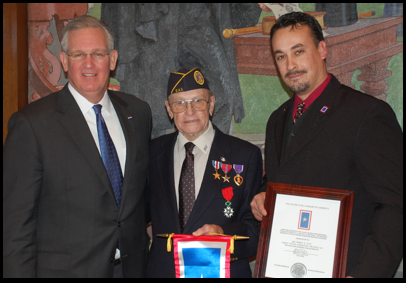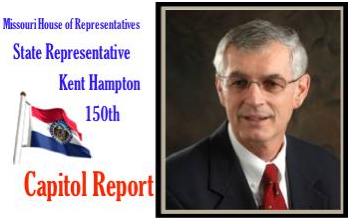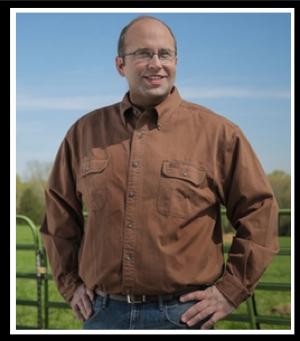
Jefferson City, Missouri – Gov. Jay Nixon today noted the passing of decorated World War II veteran Perry Coy, of Jefferson City.
On Dec. 7, 2010, the Governor presented Coy with the Legion of Honor medal, the highest award bestowed by the people of France in recognition of great service to their nation. While serving as a U.S. Army staff sergeant, Coy distinguished himself in combat numerous times in combat during the liberation of France and the invasion of Nazi Germany, being awarded three Purple Hearts, the Bronze Star and the Silver Star – the nation’s third-highest military award.
At the State of the State address in January 2011, Gov. Nixon again recognized Coy for his service.
“This week, Missouri lost another notable member of the Greatest Generation with the passing of Staff Sgt. Coy,” Gov. Nixon said. “Heroes such as Perry Coy have stepped forward to bravely serve our country since its earliest days, and continue to do so today. Their courage is an inspiration to us all, and has kept our nation free. I salute his service and his sacrifice, and that of all those who are serving, or have served, in our armed forces – especially as so many who fought in World War II or Korea pass away. Godspeed, Staff Sgt. Coy.”
Below is the obituary from the Columbia Tribune.
Perry Eugene Coy, 88, of Jefferson City, passed away on Monday, October 14, 2013, at his home. He was born on November 8, 1924, in Bolivar, Missouri, the son of the late Fred L. and Beulah (Butler) Coy.
On June 17, 1945, Perry was united in marriage to Nina Landrum, who survives in Jefferson City. On December 5, 1974, he was united in marriage in Miami, Oklahoma, to Mary Lou (Kauffman) Holmes, who preceded him in death on November 17, 2010. Perry worked for Western Hatchery until 1960 before starting Fire and Safety Equipment Company, which he owned and operated until his retirement in 1998.

Perry served our country in the United States Army during World War II, where he received five Bronze Stars, the Silver Star and two Purple Hearts.
He was in the second wave of the D-Day Invasion at Normandy, and served under General Patton in the Battle of the Bulge. On October 19, 2010, he was awarded the Knight of the Legion of Honor by the government of the French Republic, the highest honor that France can bestow on a person.
Perry was recognized at the State of the State Address before the Missouri General Assembly on January 11, 2011, for his service to our country. Perry was a special friend to many. He loved to dance, always had a joke to tell and enjoyed hearing about his great-grandson's baseball accomplishments.
An avid golfer and member of the USGA, Perry won many tournaments, had seven holes-in-one, and would never pass up the chance to play, even up to two weeks ago. Perry was a member of the First Christian Church, where he served as Deacon. He was also a member of the American Legion, the Fraternal Order of Eagles, the Veterans of Foreign Wars and Redfield Golf Club.
Perry is survived by two sons: Dennis (Cari) Coy of Jefferson City, Mo. and David Coy of Licking, Mo.; one daughter: Eden (Larry) Davis of Bloomington, Ill.; two step-sons: Larry Holmes of Versailles, Mo. and Tom (Marilyn) Holmes of Columbia, Mo.; two granddaughters: Mandy (Matt) Hoener of Jefferson City, Mo. and Abby Davis of Bloomington, Ill.; one grandson: Drew Davis of Chicago, Ill.; one great-grandson: Brenden Hoener of Jefferson City, Mo.; and one special niece: Evelyn (Jim) Edwards of Springfield, Mo. Perry was preceded in death by his wife, his parents, two brothers: Fred L. Coy Jr. and John Coy, and two sisters: Lena Shipley and Goldie Evelyn Hendrix.
Friends will be received from 4:00 p.m. to 7:00 p.m., Thursday at the Houser-Millard Funeral Home, where funeral services will follow at 7:00 p.m., with Rev. Don Carter officiating.
Full military honors will follow the funeral service at Houser-Millard Funeral Home. A private family interment will be held at Hawthorn Memorial Gardens.
Expressions of sympathy may be made to the Jefferson City High School Golf Team or the Helias Catholic High School Golf Team. Arrangements are under the direction of HOUSER-MILLARD Funeral Directors, 2613 West Main Street, Jefferson City, MO 65109. (573) 636-3838. Condolences may be left for the family online at www.millardfamilychapels.com

Submitted by
Dee Loflin, SMT Manager/Editor
The Mason Dixon Line
On this day in 1767, Charles Mason and Jeremiah Dixon complete their survey of the boundary between the colonies of Pennsylvania and Maryland as well as areas that would eventually become the states of Delaware and West Virginia. The Penn and Calvert families had hired Mason and Dixon, English surveyors, to settle their dispute over the boundary between their two proprietary colonies, Pennsylvania and Maryland.
In 1760, tired of border violence between the colonies' settlers, the British crown demanded that the parties involved hold to an agreement reached in 1732. As part of Maryland and Pennsylvania's adherence to this royal command, Mason and Dixon were asked to determine the exact whereabouts of the boundary between the two colonies. Though both colonies claimed the area between the 39th and 40th parallel, what is now referred to as the Mason-Dixon line, finally settled the boundary at a northern latitude of 39 degrees and 43 minutes. The line was marked using stones, with Pennsylvania's crest on one side and Maryland's on the other.
When Mason and Dixon began their endeavor in 1763, colonists were protesting the Proclamation of 1763, which was intended to prevent colonists from settling beyond the Appalachians and angering Native Americans. As the Britons concluded their survey in 1767, the colonies were engaged in a dispute with the Parliament over the Townshend Acts, which were designed to raise revenue for the empire by taxing common imports including tea.
Twenty years later, in late 1700s, the states south of the Mason-Dixon line would begin arguing for the perpetuation of slavery in the new United States while those north of line hoped to phase out the ownership of human chattel. This period, which historians consider the era of "The New Republic," drew to a close with the Missouri Compromise of 1820, which accepted the states south of the line as slave-holding and those north of the line as free. The compromise, along with those that followed it, eventually failed.
One hundred years after Mason and Dixon began their effort to chart the boundary, soldiers from opposite sides of the line let their blood stain the fields of Gettysburg, Pennsylvania, in the Southern states' final and fatal attempt to breach the Mason-Dixon line during the Civil War.
As you read this there are only 76 days left in this year, and 84 days until your Missouri House reconvenes at the start of 2014. In the hustle and bustle of life, we sometimes become so consumed in our own lives and schedules that we fail to take notice and care for others. Let me encourage you this week to speak to at least ten people you don’t know, hold the door open for five, and invite a minimum of two people to church. You never know the influence or encouragement you may play in someone’s life. Give thanks. See ya at church Sunday!
As always, it is an honor to serve you in the Missouri House. If you would like to discuss any issue, please call 573-751-3629. You can also email me at kent.hampton@house.mo.gov . I look forward to hearing from you.

Submitted by
Dee Loflin, SMT Manager/Editor
Cardinals Quest for a World Series Championship
On October 6, 1926, Yankee slugger Babe Ruth hits a record three homers against the St. Louis Cardinals in the fourth game of the World Series. The Yanks won the game 10-5, but despite Ruth’s unprecedented performance, they lost the championship in the seventh game. In 1928, in the fourth game of another Yanks-Cards World Series, Ruth tied his own record, knocking three more pitches out of the same park.
The 1926 championship promised to be an exciting one. The AL champs had a powerful lineup, later called the "Murderer’s Row," that included the great Babe, the young "Columbia Lou" Gehrig, and the leadoff man Earle Combs. For their part, the Cardinals had the intimidating Rogers Hornsby along with ace pitchers Flint Rhem and Bill Sherdel.
But the Yanks were heavily favored, and they won the first game easily. They lost the second, though, thanks to an outstanding full-game performance from St. Louis pitcher Grover Cleveland Alexander. The next day, Cardinal Jessie Haines pitched the whole game--and hit the only home run--in his team’s 4-0 Game 3 victory.
By the fourth game in the series, the underdog Cards were up two games to one. The Yanks needed to pull it together, and for one game, they did. Veteran Waite Hoyt pitched all nine innings while St. Louis shuffled through its entire bullpen. And the Babe--the Sultan of Swat, the Caliph of Clout, the Wali of Wallop--hit his three homers and led the Yanks to a 10-5 victory. Unfortunately for the Bombers, that game didn’t decide the series. Though they won the next game in 10 innings, they lost the next one by eight runs. And they were losing the seventh game by one run in the ninth inning when the Bambino stepped to the plate again. With a 3-2 count, Ruth drew his eleventh walk of the series and trotted off to first base. The Yanks’ hopes plummeted as quickly as they’d risen, though, when second baseman Hornsby nabbed him as he tried somewhat ploddingly to steal second. The game was over. Thanks to the magical Bambino, the Bombers had lost.
On October 18, 1977, Yankee Reggie Jackson became only the second player to hit three homers in a single Series game.
As the fresh air of October arrives and the regular season of baseball has ended, some are packing up and going home. But, our St. Louis Cardinals are preparing for the playoffs and hopefully the Fall Classic World Series. Aside from the updates on the weather, questions and recent developments about the Cardinals are a hot topic. With all the differing issues and opinions we may have formed, continue to focus on the freedoms we enjoy knowing the price that was shed for those, and without any doubt who is in charge. Give thanks that we live in the greatest country in the world. See ya in church Sunday!
As always, it is an honor to serve you in the Missouri House. If you would like to discuss any issue, please call 573-751-3629. You can also email me at kent.hampton@house.mo.gov . I look forward to hearing from you.

Submitted by
Dee Loflin, SMT Manager/Editor
The United States Capitol Building
On this day in 1793, George Washington lays the cornerstone to the United States Capitol building, the home of the legislative branch of American government. The building would take nearly a century to complete, as architects came and went, the British set fire to it and it was called into use during the Civil War. Today, the Capitol building, with its famous cast-iron dome and important collection of American art, is part of the Capitol Complex, which includes six Congressional office buildings and three Library of Congress buildings, all developed in the 19th and 20th centuries.
As a young nation, the United States had no permanent capital, and Congress met in eight different cities, including Baltimore, New York and Philadelphia, before 1791. In 1790, Congress passed the Residence Act, which gave President Washington the power to select a permanent home for the federal government. The following year, he chose what would become the District of Columbia from land provided by Maryland. Washington picked three commissioners to oversee the capital city's development and they in turn chose French engineer Pierre Charles L'Enfant to come up with the design. However, L'Enfant clashed with the commissioners and was fired in 1792. A design competition was then held, with a Scotsman named William Thornton submitting the winning entry for the Capitol building. In September 1793, Washington laid the Capitol's cornerstone and the lengthy construction process, which would involve a line of project managers and architects, got under way.
In 1800, Congress moved into the Capitol's north wing. In 1807, the House of Representatives moved into the building's south wing, which was finished in 1811. During the War of 1812, the British invaded Washington, D.C., and set fire to the Capitol on August 24, 1814. A rainstorm saved the building from total destruction. Congress met in nearby temporary quarters from 1815 to 1819. In the early 1850s, work began to expand the Capitol to accommodate the growing number of Congressmen. In 1861, construction was temporarily halted while the Capitol was used by Union troops as a hospital and barracks. Following the war, expansions and modern upgrades to the building continued into the next century.
Today, the Capitol, which is visited by 3 million to 5 million people each year, has 540 rooms and covers a ground area of about four acres.
Historic Veto Session Comes to a Close
While it lasted only a day, the 2013 veto session was truly historic as the legislature shattered the previous mark for overrides of the governor’s vetoes. Coming into the session the legislature had 29 vetoed bills to consider. After the dust settled late Wednesday night, the House and Senate had collaborated to override 10 of the governor’s vetoes.
Veto sessions have different meanings to citizens and legislators. We are mandated by the Missouri Constitution to meet annually for a veto session. To some it is an opportunity to inform the public of the merit of the bills, and question or identify issues that the bill possesses through messaging and choosing to either override a veto or sustain the existing veto. Others, however, may view it as being along party lines regardless of the subject matter or the voice of their constituents. I stand strong in my beliefs and will continue to put people before party.
See ya in Church Sunday!
As always, it is an honor to serve you in the Missouri House. If you would like to discuss any issue, please call 573-751-3629. You can also email me at kent.hampton@house.mo.gov . I look forward to hearing from you.

Submitted by
Dee Loflin, SMT Manager/Writer
Poplar Bluff, Missouri - On Monday, September 16th, Congressman Jason Smith will open a district office in Poplar Bluff. Smith will be on hand to officially open the office and to meet with his constituents. Smith hopes his Poplar Bluff office will allow him to be closer to his constituents and to ultimately represent the Eighth District more effectively in Washington, D.C.
“We are excited about opening an office in Poplar Bluff. Poplar Bluff is one of the fastest growing communities in our Eighth Congressional District and having a district office there shows my commitment to the area,” said Smith. “To my knowledge, this is the very first time Poplar Bluff has had an office for their federal representative. I want to invite the entire community to join us on Monday for the office opening.”
State Senator Doug Libla, praised Smith’s decision to open an office in Poplar Bluff.
“Poplar Bluff is one of the fastest growing and exciting communities in Southeast Missouri. It makes sense to have a congressional office in our town, and will give citizens direct access to Congressman Smith’s office. I’m happy that Congressman Smith recognizes that Poplar Bluff has been a leader in maintaining, plus attracting new businesses and families, to the region.” said Libla.
State Representative Todd Richardson also welcomed news of Smith opening an office in Poplar Bluff.
“I'm excited to see Congressman Smith open an office here in Poplar Bluff. I know Congressman Smith is passionate about serving the people of this area and has a strong commitment to this part of the 8th district. This office is an indication of that commitment and will serve the people of this area well,” said Richardson.
WHO: Congressman Jason Smith
WHAT: Opening of Poplar Bluff District Office
WHERE: 2911 North Westwood Blvd., Suite C, Poplar Bluff, MO
WHEN: Monday, September 16, 2013 from 10:00AM-11:00AM

